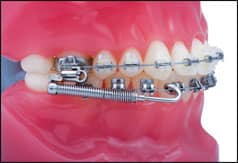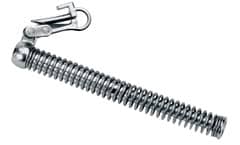by Alan Ruskin
Lisa Alvetro, DDS, MSD, finds the Forsus Appliance to be a simple and effective alternative to elastics
 |
Compliance, compliance, compliance! When it comes to Class II correction, says Lisa Alvetro, DDS, MSD, “compliance, or lack of it, is a major issue.”
The traditional technique for correcting overbite malocclusion—involving the use of Class II elastics and headgear—has been problematic, Alvetro says, because it’s harder to convince kids to actually wear the headgear and elastics. “I’ve spent a lot of time coaching kids, trying to get their cooperation. I’ve been doing it for 17 years. Noncompliance is a big problem because the orthodontist is dependent on the patient for getting it right. We’re asking a lot from them over a long period of time.
“The doctor loses control over predictability and efficiency when the process is patient-dependent. Today’s kids don’t want to wear headgear 12 hours a day and the elastics for 24 hours, with changes twice a day. And worse yet, if they don’t cooperate at the age of 13, they may be stuck with the problem, unable to fix it later.”
 |
| Lisa Alvetro, DDS, MSD |
That loss of control can also sometimes result in friction with the families of the patients. “Some heated discussions can ensue,” Alvetro says, “over why it’s taking so long. ‘When are the braces coming off?’ The parents can become impatient and argumentative, but the reason is always their child’s noncompliance.”
Good Idea, Kid!
From her office in Sidney, Ohio, Alvetro notes that, “I’ve spent a lot of time coaching kids.” The past tense is key, because Alvetro’s problem with noncompliance, once an issue with about half of her patients, is now history. Her adoption of the Forsus™ Class II Corrector fixed functional appliance from 3M Unitek, Monrovia, Calif, has changed all that. According to Alvetro, the appliance resulted in something of a revolution in the art of moving teeth, from which she and her patients have benefited considerably.
The Forsus Fatigue Resistant Device first appeared on the market in 2001, and Alvetro began using it as a device to switch to when the customary Class II elastics treatment plan proved unsatisfactory in some cases. Then, a while later, a rather novel event occurred when a certain young man voiced his opinion. Alvetro remembers, “One of my patients, a kid whom I had changed over to the Forsus Appliance when elastics weren’t working, suggested that instead of wasting time with the elastics, I should use Forsus right from the beginning. I thought, ‘Why not?’—and have been using it pretty much exclusively since 2004.” Of course, she adds, “I didn’t tell the kid—he’d never let me forget it!”
 |
| When correctly activated, the Forsus Appliance’s spring exerts about 200 grams of force |
Forces at Work
One of the key advantages of Forsus Correctors, Alvetro explains, is the force factor. “When correctly activated, Forsus exerts about 200 grams of force, which is comparatively low, but effective. Coming from one main, streamlined component, the light force means you won’t see a lot of unwanted tooth movement, especially of the lower incisors. It’s important to orthodontists to avoid tipping forward of the lower front teeth to help prevent bone loss.”
In addition, elastics tend to have a vertical as well as forward and backward force factor, and the vertical force can cause extrusion of the lower molars, increasing lower face height. “This works against Class II correction,” Alvetro points out, “a problem avoided by Forsus Correctors, which have a better force factor.”
She says she still uses elastics occasionally, but only in very mild cases, “where not a lot of movement of the teeth or compliance is needed.”
A Comfortable Fit
Another big factor is comfort. Alvetro says, “Forsus Correctors are simple, small, and compact compared to other fixed appliances—they have relatively few components.” This makes for ease of insertion and greater comfort. “Elastics produce pressure, soreness, and cheek irritation, which is not the case with Forsus.” The Forsus™ EZ Module also features an antirotation arm that prevents the module from “rolling” and causing the patient discomfort due to soft-tissue irritation.
Alvetro adds, “It’s also a considerable improvement over earlier fixed appliances, such as the Herbst, which is bulkier, more rigid, has more components, requires a greater learning curve, and takes more time to install. Installation of Forsus takes only about 20 minutes—about half the chairtime of other methods—and follow-up visits, including return visits for activation and removal, are also very quick.”
Aesthetics are improved as well, Alvetro notes, because she attaches the device further back in the mouth, behind the bicuspid, “so there is less visibility of the appliance when opening the mouth, which, of course, is cosmetically desirable.”
3M Unitek recently began to offer a shorter attachment that assists in bicuspid installation.
The most recent innovation in the Forsus Appliance product line is the click-in-place clip of the Forsus EZ Module. According to the 3M Unitek Web site, the clip “clicks” into a standard buccally offset occlusal headgear tube by inserting it with any Weingart-style pliers. Mesial and distal stops on the clip are designed to provide a secure fit.
The Proof Is in the Patients
Alvetro also notes that the Forsus Appliance has a high rate of patient acceptance. She says, “There’s no big adjustment period as there is with some other appliances. It takes kids about as long to get used to the spring (Forsus device), which goes on about halfway through the treatment, as it takes for them to adjust to the braces at the beginning of treatment.”
Durability is another reason Alvetro has stuck with her Class II corrector of choice. “You don’t see much breakage with Forsus Appliances,” Alvetro says.
|
To read more articles on this topic, for “Class II”. |
“I won’t say they never break,” Alvetro adds, frankly. “Kids who can break their braces, especially rough, tough, teenage boys, can break just about anything. But if there is an emergency, it’s a very quick fix to replace the component that’s broken. You don’t have to take the whole thing out and start over. Maintenance as well as installation is very easy with Forsus Correctors.”
She mentions a satisfaction survey she conducted at her practice. “We asked our patients, ‘Would you recommend this to a friend?’ The response was an unqualified ‘yes,’ mostly because they felt they didn’t have to do anything, that Forsus is automatic.”
Alvetro concludes, “Getting away from dependency on patient compliance, being able to predict treatment outcome, maintaining control over the whole process—that’s what it’s all about.”
Alan Ruskin is a staff writer for Orthodontic Products. Please send questions and comments to










